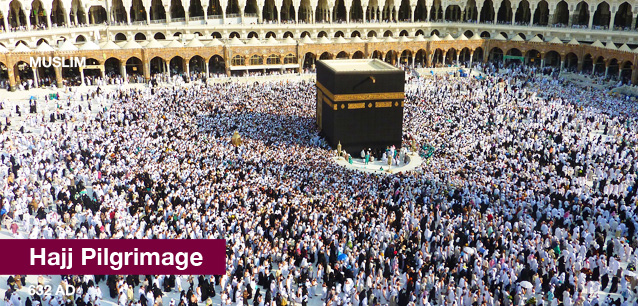 AD
AD
Today is: June 19
Scroll to explore events active on this date.
LEEP INK FEATURES

May Blooms: Events in May 2025
Along with October, May is one of the most densely packed months of the year. It's before the summer humidity and the last whole month of the school year. The weather is warming in t...

Sweet June 2025
The solstice on the 20th marks the onset of summer (Northern Hemisphere) or winter (Southern Hemisphere). Many people, particularly in Europe, North America and Asia, will be embarking o...

Events in April 2025
Spring has sprung in the north, and the first hints of Autumn are on the horizon in the south. April is the month spring (or fall) gets underway, and it is filled with religious celebrations, including the Mu...
About the Muslim Tradition of Hajj
Travel & Tourism , Middle East/West Asia
Ends: Jun 09, 2025
DESCRIPTION:
Dhu al-Hijjah is the 12th and last month in the Islamic Calendar, the final of four sacred months, and the month of Hajj. Performing Hajj occurs between the 8th to 12/13th of the month and is one of Islam's five pillars or fundamental acts that define the faith.
Hajj is the pilgrimage to Mecca that devout Muslims endeavor to do at least once in their lifetime. When performed during the first 8-12/13 days of the Islamic month of Duh al-Hijjah, it is called Hajj, and when practiced at other times of the year, it is called Umrah.
The following is a general description of Hajj al-Tamatt'u, the most common pilgrimage.
Each year during Hajj, millions of people from around the world descend on the Saudi Arabian city of Mecca to perform the rituals of Hajj. One of the first places visited is the black box, the Kaaba. Muslims walk around counterclockwise seven times, three separate times during the pilgrimage. The word for this encircling is "tawaf."
The Kaaba marks where Muslims believe Adam and Eve built the first house of worship, and Abram (hereafter referred to as Abraham (Ibrahim)) rebuilt it thousands of years later. In the Muslim faith, they refer to this as "the first house of the only true God." It is the Kaaba that Muslims face when they pray.
Muslims believe it was here that God asked Abraham to sacrifice his son Ishmael.* The Kaaba is believed to be the same size as Abraham's original temple.
Performing Hajj is a 5-6 day process and represents one of Islam's five pillars.
FIVE PILLARS OF ISLAM
Charity
Testimony of faith
Praying five times a day
Fasting during the month of Ramadan
Performing Hajj
All acts of devotion during the first ten days of Dhu al-Hijjah are highly rewarded and blessed.
Fasting on the 9th day is known as al Nisai and Abu Dawud. Fasting on this day removes one's sins for the next two years.
How is Hajj performed?
Day 1) Commences on the 8th day of the Islamic month of Dhu al-Hijjah
Step 1) Muslims change from everyday wear to ceremonial clothing called "ihram" upon arriving. Often in the airports around Saudi Arabia, you will see pilgrims flying in traditional clothing before arrival.
Step 2: Dressed in their ihram, pilgrims perform "tawaf," circling the Kaaba seven times (3 times running, four times walking) counterclockwise.
Step 3) After performing the first tawaf, pilgrims walk between the two hills of Safa and Marwa several times to the town of Mina, where they spend the night. The hills are where Hagar ran back and forth seven times, looking for water for Ishmael, and God took pity and created a spring for her. Pilgrims replicate the running back and forth through this ritual called "masa." The spring Muslims believe God created for Hagar is called Zamzam.
Mina, where the day's journey ends, is the location of the three pillars (Jamrat al-Aqaba, Jamrat al-Wusta & Jamrat al-Sughra), representing the three times the devil tempted Abraham.
Day 2: Performed on the 9th day of the Islamic month of Dhu al-Hijjah
Step 1) This day is about walking from Mina to Arafat, approximately 6 miles; it is called the "waqf," or day of vigil. Pilgrims stand from noon until sunset in Arafat as part of Hajj, and Arafat is where the prophet Mohammed delivered his last sermon in 632 AD.
Step 2) Leaving Arafat after nightfall, pilgrims walk to Muzdalifa, about 4 miles, and collect 49 stones along the way. They spend the night in Muzdalifa under the stars, and most pilgrims will fast on this day.
Day 3: Eid al-Adha, the 10th day of the Islamic month of Dhu al-Hijjah
Step 1) Pilgrims walk from Muzdalifa to Mina and throw stones at the devil represented by the largest of the three pillars (Jamrat al-Aqaba). Day three is a day of celebration.
Step 2) Pilgrims continue walking to Mecca from Mina to perform the second tawaf, walking seven times around the Kaaba.
Step 3) Then they walk again between the hills of Safa and Marwa, returning to Mina.
Step 4) Animals are sacrificed. The meat is cooked and distributed to commemorate Abraham's willingness to sacrifice his son to God and God's acceptance of a sheep instead. A vast feast follows, with large portions going to the poor. Unlike sacrifices in other faiths, in Islam, the gift of an animal's life is not done to please God. It is performed to remember Abraham's obedience and for charity. One sheep or goat equals one person, and a camel or cow's sacrifice equals seven people. Only those who can afford to make a sacrifice will do so, often paying for those without funds.
Days 4-6: the 11th - 13th days of the Islamic month of Dhu al-Hijjah
On each day of this final period (2 or 3 days), pilgrims return to the three pillars representing the devil and stone them in a specific order. This uses up the remaining stones of the 49 collected on the second day. On the final day of Hajj, pilgrims change clothes, replacing the "iharm" with their standard attire to perform their third and final tawaf around the Kaaba.
Upon completing Hajj, Muslims may now refer to themselves as 'alhaji' (male) or 'alhaja' (female). Like confirmation in Christianity or Bar/Bat Mitzvah in Judaism, this is a title of accomplishment in the Islamic faith.
_________
*NOTE: The son referenced in this story is an area where Islam, Judaism, and Christianity differ in scripture. Christians and Jews believe it was Isaac, the son of Abraham's first wife, Sara. Muslims believe it was Ishmael, the son of Sara's handmaid Hagar, Abraham's second wife.
PLEASE NOTE:
Islamic holidays are determined in Mecca by the position of the moon and can occur a day earlier or later than posted.
VIDEOS
SUPPORTING DOCUMENTS
Currently, this event does not have supporting documents.
ADDITIONAL IMAGES
Where would you like to go now?
 AD
AD
By using this site. You are agreeing to use of cookies. Learn more in our Privacy Policy


/footer-logo.svg)
